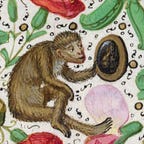Peripatetic School of Thought With Magritte
“My paintings are visible images which conceal nothing; they evoke mystery and, indeed, when one sees one of my pictures, one asks oneself this simple question, ‘What does that mean?’.” — RM
Willingly, subconsciously, or just by the semantic power of these letters, Aristotle and Magritte enter a space of conversation. A dynamic space surely; one where they — we — are allowed to walk.
There is no walk, no flight, no conversation or discourse of course here. It is just a painting — scratch that, a reproduction of a painting — depicting what our mind sees as a conversation. And the mind is the only one really there: the mind sees the flight, the mind gives meaning to the distance between the bowler hat men’s feet and the ground. The mind says: that is the flow state of discourse, getting lost in conversation so much so that you forget the road, you forget your feet are on the ground. You talk about high ideals.
High ideas… what would Aristotle tell Magritte now, if my mind’s interpretation was in fact the author’s intention.
Plato (c. 427–c. 347 BCE) believed that the facts of our world could only be properly understood by considering them in their ideal forms or abstract essences. In terms of instances, he believed that not only do numerous bowler hats exist — a little futuristic for him, but…
